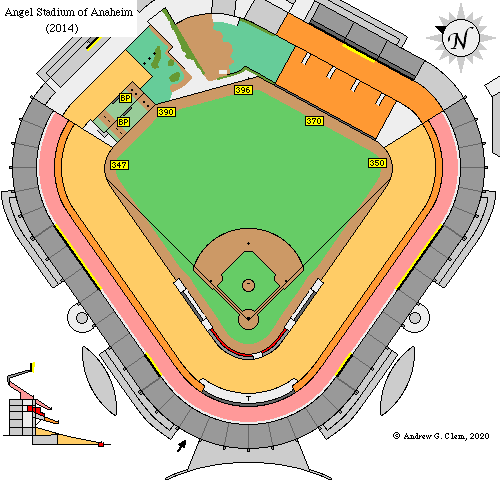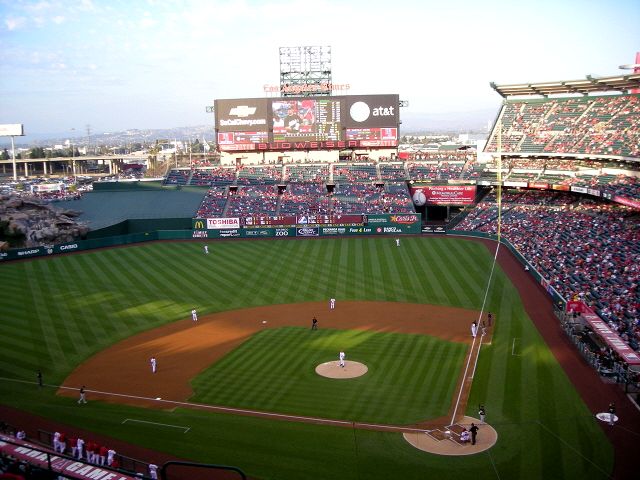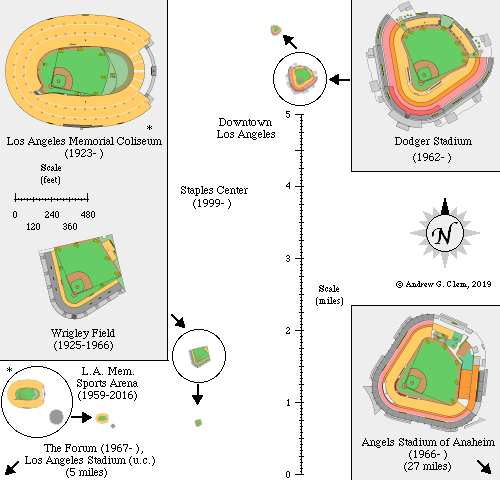ALL STAR GAMES: 1967, 1989, 2010 WORLD SERIES: 2002 (1 win, 0 losses)
After spending four years as tenants of the Dodgers, and one year after changing their geographical affiliation from "Los Angeles" to "California," in 1966 the expansion Angels franchise loaded up their trucks and moved to beautiful downtown Anaheim, 25 miles away to the southeast. Their new home, Anaheim Stadium, was conveniently situated near a passenger train station and the Santa Ana River, about two miles east south east of Disneyland. It was a rather ordinary three-deck stadium with a symmetrical layout and dimensions almost identical to their prior (leased) home. In fact, it was basically a slimmed-down carbon copy of Dodger Stadium, where they had played from 1962 to 1965 (though they called it "Chavez Ravine"), complete with short outfield fences between the bullpens and the foul poles. There were no bleachers in the outfield, however, just a big parking lot with a huge halo-tipped "A"-shaped structure upon which the scoreboard was mounted. There was no fourth deck, either, and foul territory here was much smaller than at Dodger Stadium.
To accommodate the Los Angeles Rams football team, who decided to move out of ancient Memorial Coliseum, Anaheim Stadium underwent a massive expansion in 1979-1980. As a result, the seating capacity for baseball games rose by nearly 22,000, as the playing field became completely enclosed. Unlike the original upper deck, there was no lateral aisle in the expanded portion of the upper deck, making it difficult for fans to move from section to section. Two extra rows of seats filled that space. (Seldom were those outfield upper deck seats ever filled for baseball games, however.) The reconfiguration scheme was very similar to that of Candlestick Park, which given the broader arc of the grandstand around the diamond, was better suited for football all along. With the additional seats installed for football games in front of the forward-extended "second deck" in right field, the total capacity was 69,000. Offsetting the new seating sections was the loss of three sections of seats in the upper deck on the third base side, where a large, new multi-level press box for football games was built. (See the "roofless" third-deck diagram above.) There was a smaller press box in that same location occupying the top six or so rows of seats prior to 1980, suggesting that some football games may have been played in Anaheim Stadium during the 1970s, but it is uncertain when it was built.
Just as the stadium expansion began, the Angels started winning big for the first time. They were divisional champions in 1979, 1982, and 1986 but never made it to the World Series -- until 2002! Several top-caliber players wore Angels uniforms at one time or another, most notably Nolan Ryan, who led the American League in strikeouts seven times during the 1970s. Reggie Jackson, Rod Carew, Frank Robinson, Don Baylor, and Hoyt Wilhelm also played for the Angels.
On January 18, 1994 Anaheim Stadium was damaged by an earthquake, as a 17.5-ton Jumbotron scoreboard suspended from the roof in left field, along with part of the roof and adjoining signs, crashed into the upper deck. The scoreboard was rebuilt, but at the rear of the upper deck, and the roof in that part of the stadium was permanently removed. (The 1995 "combined" diagram above depicts the reconstructed form, but the football gridiron therein was only representative of the 1980-1994 period.)
 Anaheim Stadium was never a satisfactory place to play football, and the Rams left Anaheim and moved to St. Louis in 1995. As with Shea Stadium, Busch Stadium II, and other dual-use "hybrid" structures, the very reason for the awkward accommodation to the erstwhile football partners suddenly vanished, leaving the Angels in the lurch. As the Indians, the former Expos, and the Marlins learned, playing in front of all those empty seats game after game can be depressing.
Anaheim Stadium was never a satisfactory place to play football, and the Rams left Anaheim and moved to St. Louis in 1995. As with Shea Stadium, Busch Stadium II, and other dual-use "hybrid" structures, the very reason for the awkward accommodation to the erstwhile football partners suddenly vanished, leaving the Angels in the lurch. As the Indians, the former Expos, and the Marlins learned, playing in front of all those empty seats game after game can be depressing.
Soon after the Walt Disney corporate behemoth bought the Angels in 1996, the team began identifying itself as the "Anaheim" Angels, and work began on demolishing most of the seating sections that had been added in 1980. Things were quite a mess during the 1997 playing season, as the seating sections close to the outfield had to be closed for safety reasons. By spring 1998, the reborn "Edison International Field" was ready for action. A major feature of the renovated stadium is the "Outfield Extravaganza" area in left center field; like Coors Field in Denver, it features big (fake) boulders and fountains, supposedly representing the California coast, with frequent fireworks displays. There is also a picnic area in back of it. (If you ask me, it would help immeasurably if they removed the olive green tarp that covers the slope on either side of the "Extravaganza" and planted real grass out there.) In aesthetic terms, the renovation had quite pleasing results overall, with considerable asymmetry in the outfield dimensions. The bullpens were moved to in front of the left field bleachers, stacked in "terrace" fashion. In right field, the high 18-foot wall in front of the right field bleachers (a left-over artifact of the "hybrid" era) was brought into play, a big challenge for left-hand sluggers. In back of the right field stands a huge new scoreboard / video screen was added.
CINEMA: There were several aerial shots of Anaheim Stadium in the movie Angels in the Outfield (1994), starring Danny Glover, Tony Danza, and Christopher Lloyd. The Angels' home games supposedly being played there were actually filmed in Oakland Coliseum, a very bad match.
As a result of the reconfiguration, the distances to center field and left-center field increased to 408 and 387 feet, respectively, and the number of home runs hit in Anaheim fell from 210 in 1997 to only 141 in 1998, the lowest in the American League. Heavy-set slugger Mo Vaughn apparently complained about this before he signed with the Angels in 1999, and to make him happy, the fence from center field to left center was brought in by about eight feet. As a result, the number of home runs that year rose to 179. Big Mo left Anaheim after two years, just as the Angels went to the World Series for the first time ever -- and won! It was a fairy tale ending that brought tears of joy to the widow of the team's original owner, cowboy movie star Gene Autry. Happy trails...
There is some uncertainty over the distances to the foul poles, which were originally 333 feet from home. After the 1998 renovations, they were marked "330." I had thought that perhaps the diamond was moved slightly in 1998, but apparently it was just a measurement correction. Lowry's Green Cathedrals states that those distances reverted to "333" in 2003, but the markers continued to say "330." Then, prior to the 2014 season, all of the distance markers were changed to correspond to the actual distance to the fence at the particular spot where the markers are located. That resulted in significant apparent increases down the foul lines, but no actual dimensions changed. Another issue is the distance to the backstop: Most sources state that it was originally 55 feet and then raised to 60.5 feet in 1973, but after checking dozens of photographs for any sign of an actual change, I'm inclined to think that it was 60 or so feet all the way from 1966 until the renovations in 1997, when below-ground seats were added between the dugouts. That reduced the distance by about four feet. Prior to the 2018 season, a new eight-foot fence was built in front of the 18-foot wall in right field, about a foot in front of the new out-of-town scoreboard.
On the very same day that this page was first posted (September 26, 2002), the Walt Disney Company announced that the Angels franchise and the "Mighty Ducks" hockey team were up for sale, but any prospective new owner had to promise to keep the teams in Anaheim. In May 2003 MLB owners approved the sale of the Angels to Arturo Moreno, the first Latino owner of an American-based professional sports team. He paid $183.5 million. Under his leadership, the Angels acquired Vladimir Guerrero and other top stars, helping to win the AL Western Division in five years from 2004 to 2009. The acquisition of Mike Trout (2012 AL Rookie of the Year) and veteran sluggers Albert Pujos and Josh Hamilton a year later raised hopes for another postseason in Anaheim, but that didn't happen until 2014, when the team really started to click. Signing former Nationals star third baseman Anthony Rendon after the 2019 season ensured that the Angels' prospects will remain high for years to come.
After the 2003 season, the Edison International Corporation backed out of the naming rights deal with the Angels, and the stadium was renamed "Angel Stadium of Anaheim." Why it didn't simply revert to the previous long-standing name of "Anaheim Stadium" is a mystery. Then in 2005 the team changed its geographical affiliation and started calling itself the "Los Angeles Angels of Anaheim." It all adds up to a team with serious identity issues -- but a mighty good team nonetheless. The Angels have been negotiating with local government officials over future development options, which might include either another major renovation of Angel Stadium, or a complete replacement thereof. The current massive parking lot -- an archaic throwback to the 1960s -- could someday be transformed into a much more lucrative entertainment hub.
SOURCES: Lowry (2006), Pastier (2007), Dow (2002), USA Today / Fodor's (1996)



 Photos below!
Photos below!
